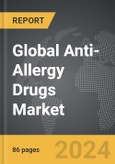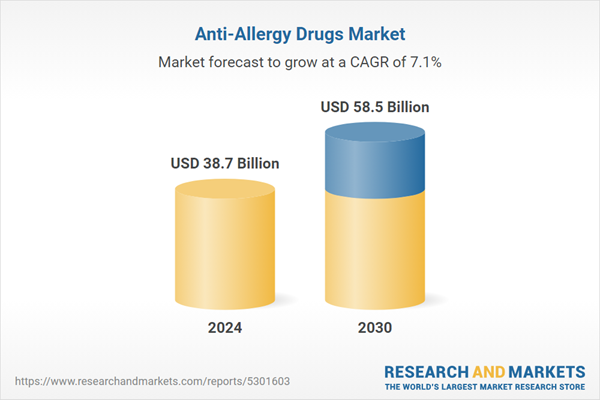The global market for Anti-Allergy Drugs was valued at US$38.7 Billion in 2024 and is projected to reach US$58.5 Billion by 2030, growing at a CAGR of 7.1% from 2024 to 2030. This comprehensive report provides an in-depth analysis of market trends, drivers, and forecasts, helping you make informed business decisions. The report includes the most recent global tariff developments and how they impact the Anti-Allergy Drugs market.
Segments: End-Use (Pharmacies, Hospitals, Other End-Uses).
Geographic Regions/Countries: World; United States; Canada; Japan; China; Europe (France; Germany; Italy; United Kingdom; Spain; Russia; and Rest of Europe); Asia-Pacific (Australia; India; South Korea; and Rest of Asia-Pacific); Latin America (Argentina; Brazil; Mexico; and Rest of Latin America); Middle East (Iran; Israel; Saudi Arabia; United Arab Emirates; and Rest of Middle East); and Africa.
The analysts continuously track trade developments worldwide, drawing insights from leading global economists and over 200 industry and policy institutions, including think tanks, trade organizations, and national economic advisory bodies. This intelligence is integrated into forecasting models to provide timely, data-driven analysis of emerging risks and opportunities.
Global Anti-Allergy Drugs Market - Key Trends and Drivers Summarized
Why Is the Anti-Allergy Drugs Market Growing Rapidly Across the Globe?
The anti-allergy drugs market has been experiencing robust growth, driven by the increasing prevalence of allergic disorders and a growing awareness of allergy management worldwide. But what exactly is fueling this expansion, and why are these drugs becoming a mainstay in both preventive and symptomatic treatment regimens? Allergic conditions, such as allergic rhinitis, asthma, and food allergies, are on the rise due to factors such as pollution, urbanization, and changing environmental conditions. These disorders can significantly impact the quality of life and, if left unmanaged, can lead to more serious complications. Anti-allergy drugs, including antihistamines, corticosteroids, decongestants, and leukotriene receptor antagonists, provide relief from symptoms like nasal congestion, itching, sneezing, and respiratory distress. Over the years, advancements in pharmaceutical formulations have made these medications more effective and better tolerated, with fewer side effects. The increasing availability of over-the-counter (OTC) anti-allergy drugs has further boosted accessibility, enabling consumers to manage mild symptoms independently. As a result, the anti-allergy drug market has seen a surge in demand, particularly in developed markets where allergic conditions are more prevalent. Additionally, the expanding range of formulations, from nasal sprays and eye drops to oral tablets and injectables, is catering to diverse patient preferences, making it easier to integrate these medications into daily routines.Which Major Trends Are Transforming the Anti-Allergy Drug Market?
The anti-allergy drugs market is undergoing significant transformation, shaped by emerging trends and shifting consumer preferences. One of the most prominent trends is the increasing demand for non-sedating and long-acting antihistamines. Unlike traditional first-generation antihistamines that often cause drowsiness and impair daily activities, newer formulations such as cetirizine, loratadine, and fexofenadine provide effective relief without sedative effects, making them ideal for daytime use. Another major trend is the rising adoption of combination therapies. Combination drugs, which integrate multiple active ingredients, are gaining popularity for providing broader symptom relief and simplifying treatment regimens. For instance, dual-action inhalers that combine corticosteroids and bronchodilators are being widely used to manage respiratory allergies like allergic asthma. Furthermore, there is a growing focus on biologics and monoclonal antibodies as targeted therapies for severe allergic conditions. Drugs like omalizumab, which specifically target immunoglobulin E (IgE), are being used to treat chronic urticaria and severe allergic asthma, offering more precise and effective treatment options for patients who do not respond to conventional medications. In addition, the increasing use of digital health platforms and telemedicine is revolutionizing allergy management by providing easier access to specialist consultations, remote prescriptions, and online monitoring of allergic conditions. These trends are not only enhancing patient outcomes but are also reshaping the landscape of allergy treatment by driving the adoption of innovative therapies and patient-centric solutions.How Are Technological Advancements and Consumer Preferences Influencing Market Dynamics?
Technological advancements and evolving consumer preferences are playing a pivotal role in shaping the dynamics of the anti-allergy drugs market. One of the most impactful innovations is the development of advanced drug delivery systems, such as nasal sprays, inhalers, and transdermal patches, which improve drug efficacy and patient compliance. These delivery systems allow for localized treatment, minimizing systemic exposure and reducing the risk of side effects. For example, the introduction of hydrofluoroalkane (HFA) propellants in inhalers has not only enhanced the delivery of asthma medications but has also made them more environmentally friendly. Another key technological breakthrough is the emergence of needle-free injectors and autoinjectors for administering biologics, making it easier for patients to self-administer treatments at home. Consumer preferences are also shifting, with a growing emphasis on natural and holistic treatments. As a result, the market is witnessing an increased interest in herbal and botanical-based anti-allergy remedies, which are being integrated into mainstream treatment options. Moreover, the rise of personalized medicine is influencing the development of allergy drugs tailored to individual genetic profiles, enabling more effective management of allergic disorders. Additionally, the growing availability of digital health tools, such as mobile apps that track pollen counts and allergy triggers, is empowering consumers to proactively manage their allergies, leading to increased demand for responsive and fast-acting medications. These advancements, combined with shifting consumer expectations, are driving innovation in both drug formulations and delivery methods, making the anti-allergy drug market more dynamic and patient-focused.What Factors Are Driving the Growth of the Anti-Allergy Drug Market?
The growth in the anti-allergy drug market is driven by several factors, primarily influenced by rising allergy prevalence, evolving treatment options, and changing consumer behaviors. One of the primary drivers is the increasing incidence of allergic disorders worldwide, which is creating a strong demand for effective medications. Factors such as urbanization, increased pollution levels, and lifestyle changes are contributing to the rise in conditions like allergic rhinitis, asthma, and atopic dermatitis, particularly in urban areas. Another significant driver is the growing preference for self-care and over-the-counter (OTC) solutions. Consumers are increasingly turning to OTC anti-allergy medications for the quick and convenient management of mild to moderate symptoms, boosting the sales of products like nasal sprays, antihistamine tablets, and eye drops. The expansion of telemedicine and e-commerce platforms is also contributing to this trend by making these products more accessible. Additionally, the market is benefiting from the introduction of innovative therapies, such as biologics and monoclonal antibodies, which offer targeted treatment for severe and chronic allergic conditions. These advanced therapies are providing new options for patients who do not respond to traditional treatments, expanding the overall market size. Furthermore, the emphasis on personalized medicine is driving the development of genetic and biomarker-based allergy tests, enabling more tailored and precise treatment regimens. These factors, combined with rising awareness of allergy prevention and early diagnosis, are propelling the growth of the anti-allergy drug market, making it a key focus area in the pharmaceutical industry’s efforts to address the global burden of allergic diseases.Report Scope
The report analyzes the Anti-Allergy Drugs market, presented in terms of units. The analysis covers the key segments and geographic regions outlined below.Segments: End-Use (Pharmacies, Hospitals, Other End-Uses).
Geographic Regions/Countries: World; United States; Canada; Japan; China; Europe (France; Germany; Italy; United Kingdom; Spain; Russia; and Rest of Europe); Asia-Pacific (Australia; India; South Korea; and Rest of Asia-Pacific); Latin America (Argentina; Brazil; Mexico; and Rest of Latin America); Middle East (Iran; Israel; Saudi Arabia; United Arab Emirates; and Rest of Middle East); and Africa.
Key Insights:
- Market Growth: Understand the significant growth trajectory of the Pharmacies segment, which is expected to reach US$35.4 Billion by 2030 with a CAGR of a 8.0%. The Hospitals segment is also set to grow at 6.3% CAGR over the analysis period.
- Regional Analysis: Gain insights into the U.S. market, valued at $10.0 Billion in 2024, and China, forecasted to grow at an impressive 10.8% CAGR to reach $14.3 Billion by 2030. Discover growth trends in other key regions, including Japan, Canada, Germany, and the Asia-Pacific.
Why You Should Buy This Report:
- Detailed Market Analysis: Access a thorough analysis of the Global Anti-Allergy Drugs Market, covering all major geographic regions and market segments.
- Competitive Insights: Get an overview of the competitive landscape, including the market presence of major players across different geographies.
- Future Trends and Drivers: Understand the key trends and drivers shaping the future of the Global Anti-Allergy Drugs Market.
- Actionable Insights: Benefit from actionable insights that can help you identify new revenue opportunities and make strategic business decisions.
Key Questions Answered:
- How is the Global Anti-Allergy Drugs Market expected to evolve by 2030?
- What are the main drivers and restraints affecting the market?
- Which market segments will grow the most over the forecast period?
- How will market shares for different regions and segments change by 2030?
- Who are the leading players in the market, and what are their prospects?
Report Features:
- Comprehensive Market Data: Independent analysis of annual sales and market forecasts in US$ Million from 2024 to 2030.
- In-Depth Regional Analysis: Detailed insights into key markets, including the U.S., China, Japan, Canada, Europe, Asia-Pacific, Latin America, Middle East, and Africa.
- Company Profiles: Coverage of players such as Allergan, Plc, Allergopharma GmbH & Co. KG., Allergy Therapeutics, Collegium Pharmaceutical, Inc, Genentech, Inc. and more.
- Complimentary Updates: Receive free report updates for one year to keep you informed of the latest market developments.
Some of the 27 companies featured in this Anti-Allergy Drugs market report include:
- Allergan, Plc
- Allergopharma GmbH & Co. KG.
- Allergy Therapeutics
- Collegium Pharmaceutical, Inc
- Genentech, Inc.
- McNeil Consumer Healthcare
- Strides Arcolab
Tariff Impact Analysis: Key Insights for 2025
Global tariff negotiations across 180+ countries are reshaping supply chains, costs, and competitiveness. This report reflects the latest developments as of April 2025 and incorporates forward-looking insights into the market outlook.The analysts continuously track trade developments worldwide, drawing insights from leading global economists and over 200 industry and policy institutions, including think tanks, trade organizations, and national economic advisory bodies. This intelligence is integrated into forecasting models to provide timely, data-driven analysis of emerging risks and opportunities.
What’s Included in This Edition:
- Tariff-adjusted market forecasts by region and segment
- Analysis of cost and supply chain implications by sourcing and trade exposure
- Strategic insights into geographic shifts
Buyers receive a free July 2025 update with:
- Finalized tariff impacts and new trade agreement effects
- Updated projections reflecting global sourcing and cost shifts
- Expanded country-specific coverage across the industry
Table of Contents
I. METHODOLOGYII. EXECUTIVE SUMMARY2. FOCUS ON SELECT PLAYERSIII. MARKET ANALYSISIV. COMPETITION
1. MARKET OVERVIEW
3. MARKET TRENDS & DRIVERS
4. GLOBAL MARKET PERSPECTIVE
UNITED STATES
CANADA
JAPAN
CHINA
EUROPE
FRANCE
GERMANY
ITALY
UNITED KINGDOM
SPAIN
RUSSIA
REST OF EUROPE
ASIA-PACIFIC
AUSTRALIA
INDIA
SOUTH KOREA
REST OF ASIA-PACIFIC
LATIN AMERICA
ARGENTINA
BRAZIL
MEXICO
REST OF LATIN AMERICA
MIDDLE EAST
IRAN
ISRAEL
SAUDI ARABIA
UNITED ARAB EMIRATES
REST OF MIDDLE EAST
AFRICA
Companies Mentioned (Partial List)
A selection of companies mentioned in this report includes, but is not limited to:
- Allergan, Plc
- Allergopharma GmbH & Co. KG.
- Allergy Therapeutics
- Collegium Pharmaceutical, Inc
- Genentech, Inc.
- McNeil Consumer Healthcare
- Strides Arcolab
Table Information
| Report Attribute | Details |
|---|---|
| No. of Pages | 86 |
| Published | April 2025 |
| Forecast Period | 2024 - 2030 |
| Estimated Market Value ( USD | $ 38.7 Billion |
| Forecasted Market Value ( USD | $ 58.5 Billion |
| Compound Annual Growth Rate | 7.1% |
| Regions Covered | Global |









